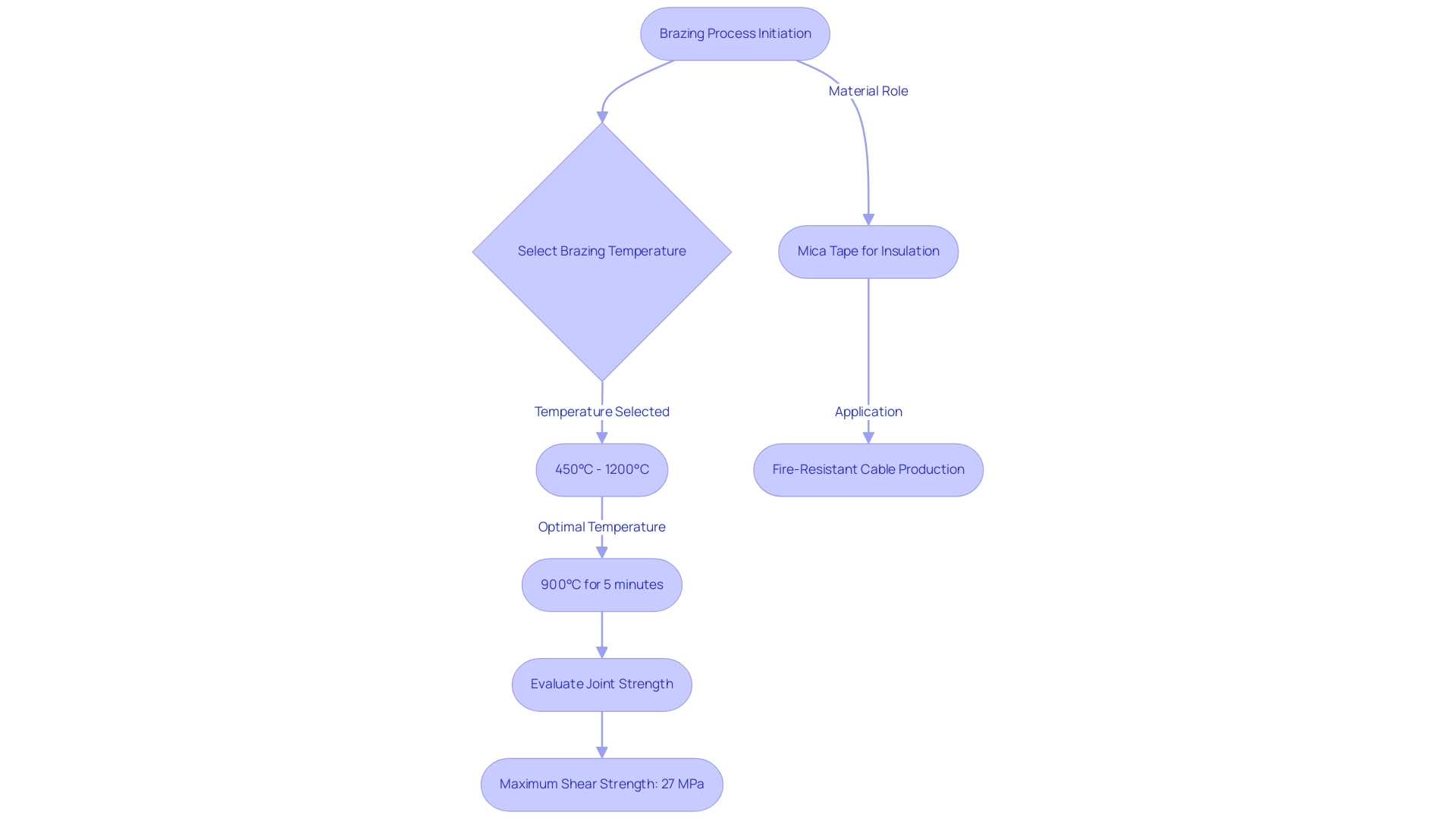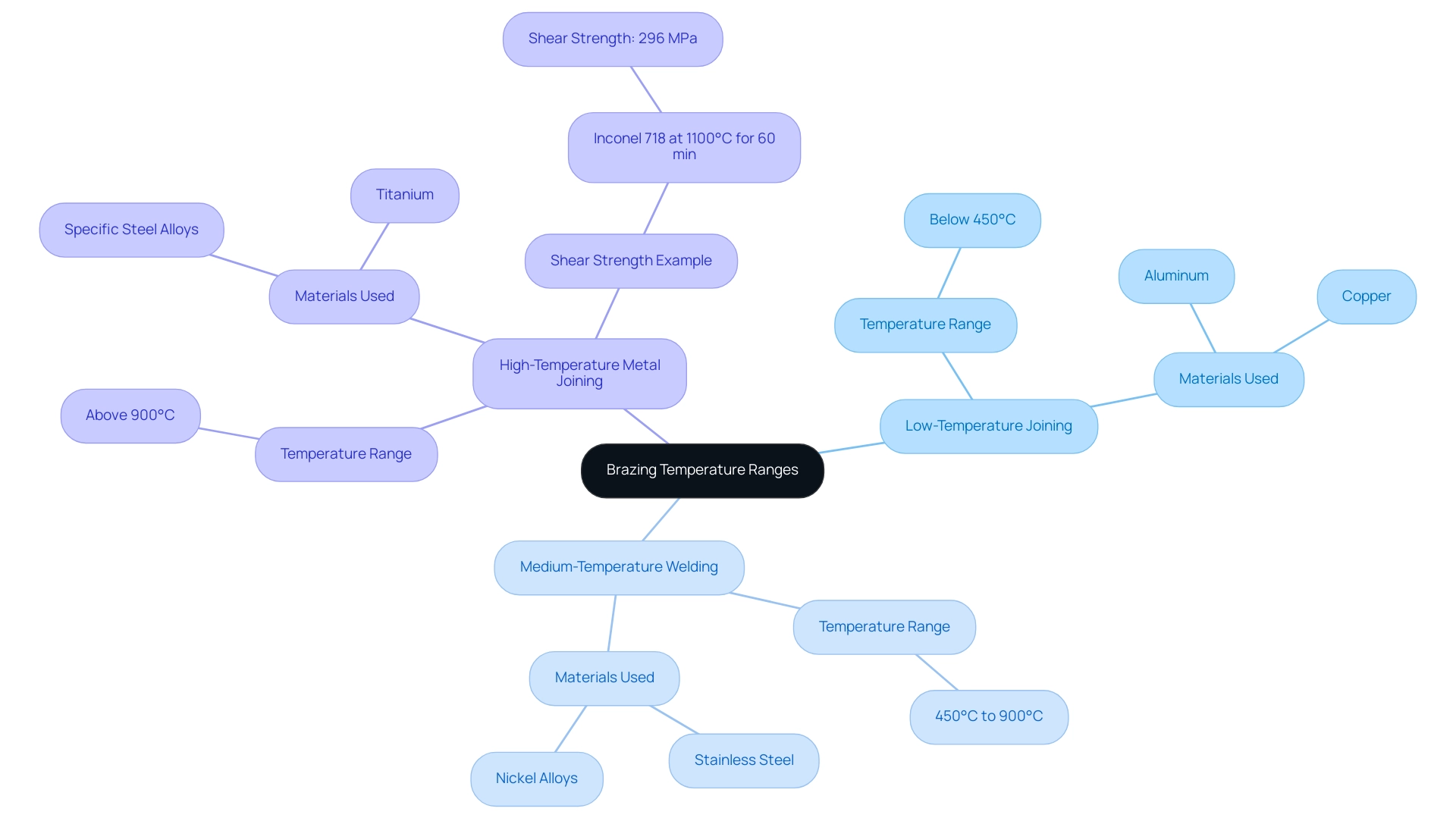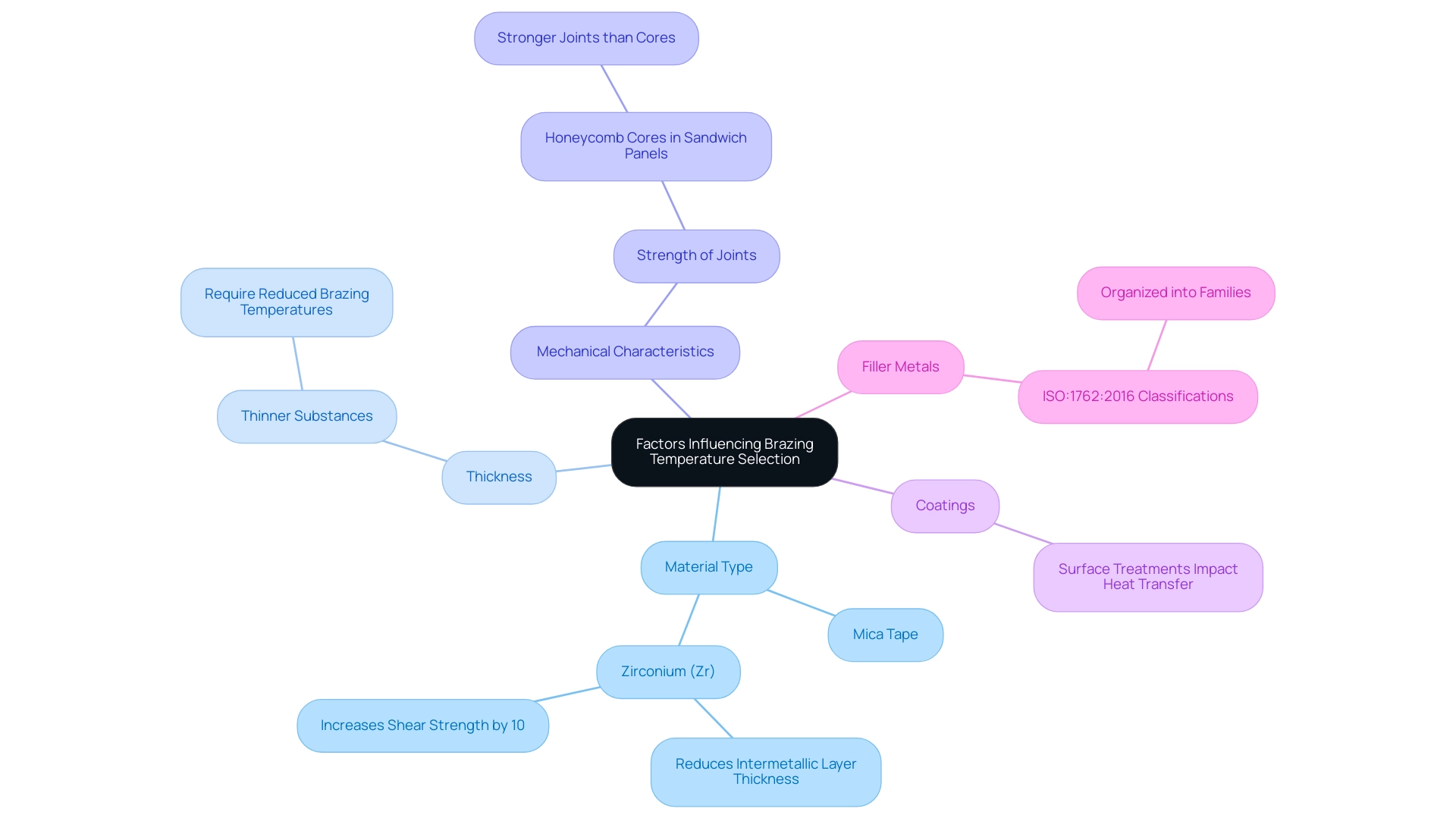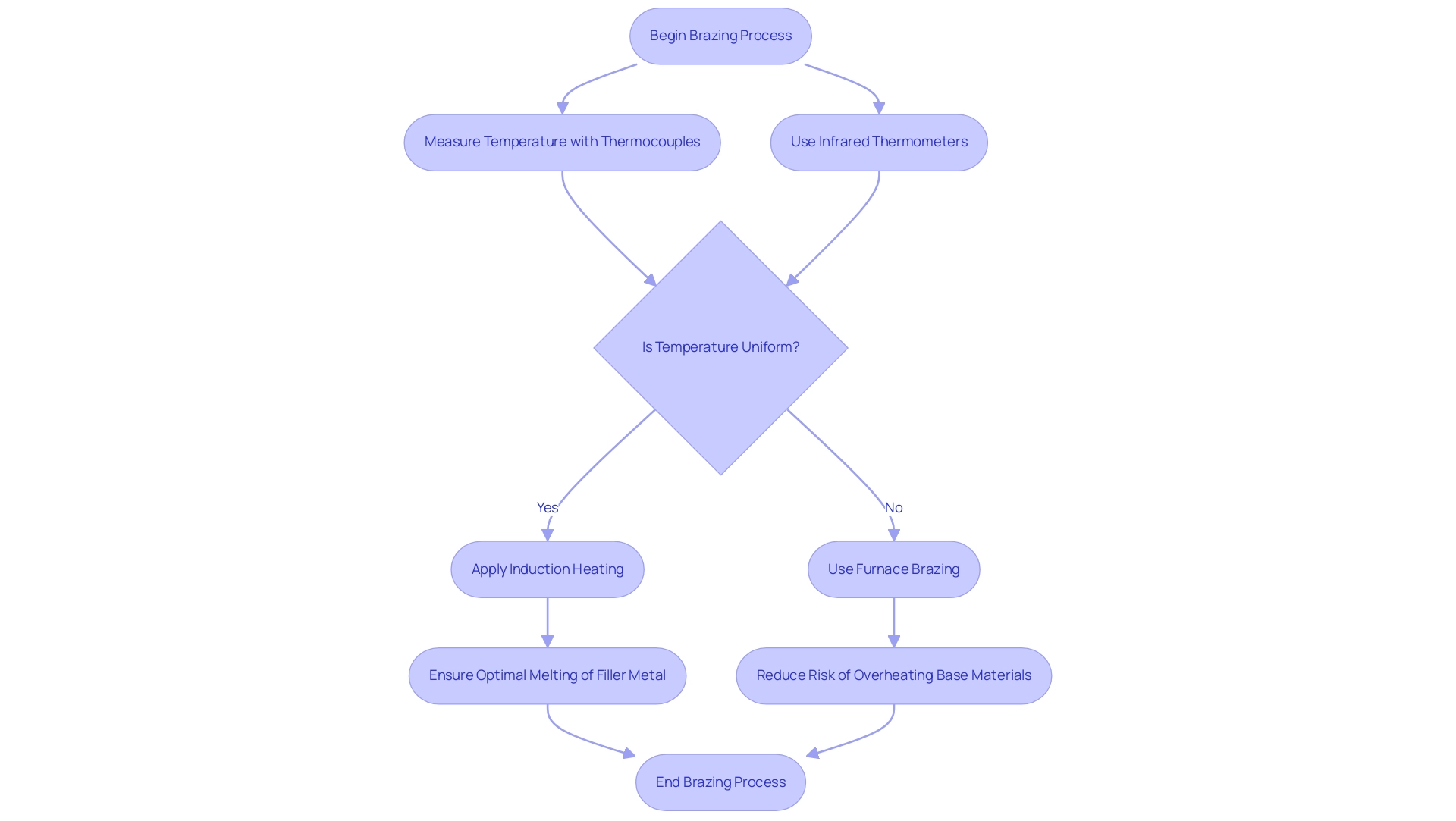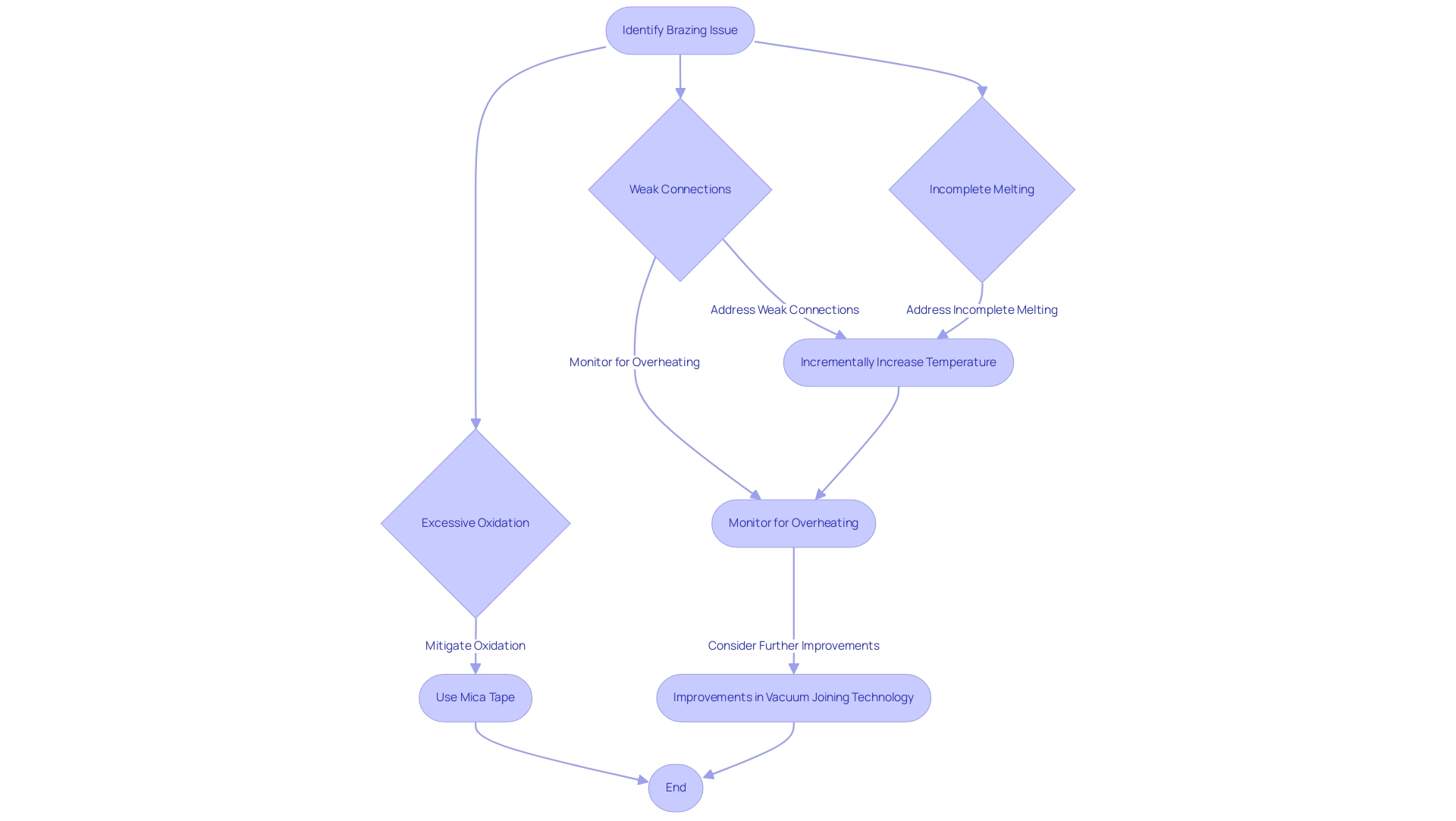Blogs
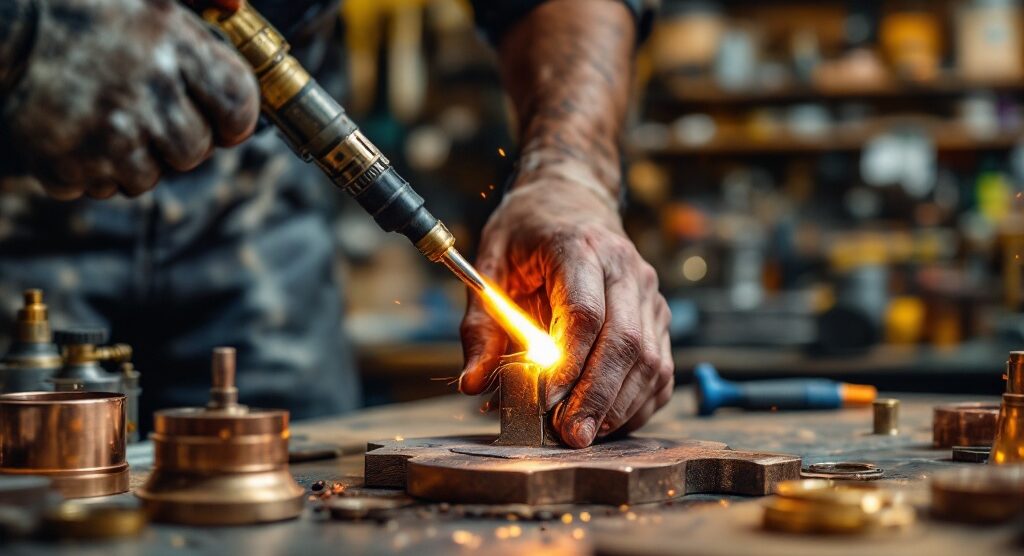
How to Determine the Right Brazing Temperatures for Your Projects
Introduction
In the realm of metal joining, brazing stands as a pivotal technique, intricately balancing temperature control and material compatibility to achieve robust and reliable joints. This sophisticated process utilizes a molten filler metal, requiring precise temperature management to ensure optimal bonding without compromising the integrity of the base materials.
With temperature ranges categorized as low, medium, and high, each application demands a tailored approach, particularly when dealing with dissimilar metals or specialized coatings. As advancements in brazing technology continue to evolve, understanding the factors influencing temperature selection becomes essential for professionals striving to enhance joint quality and performance.
This article delves into the critical aspects of brazing, from the significance of temperature control to innovative techniques and troubleshooting strategies, equipping procurement managers with the expert insights needed to navigate the complexities of this vital manufacturing process.
Understanding Brazing: Definition and Importance of Temperature
Brazing is a sophisticated metal-joining process that utilizes a molten filler metal to create strong bonds between two or more base metals. The brazing temperatures at which joining occurs are crucial; they must be adequately elevated to liquefy the filler substance while staying low enough to avoid harm to the foundational elements. Generally, brazing temperatures range from 450°C (842°F) to 1200°C (2192°F), influenced by the specific materials used and the required characteristics of the connection.
Notably, thin foils used in brazing have a thickness of approximately 50 µm, which can significantly impact the brazing process. Mastery of these thermal requirements is crucial for achieving strong and reliable connections. Mechanical property tests indicate that a joint brazed at brazing temperatures of 900 °C for five minutes achieves a maximum shear strength of 27 MPa, underscoring the importance of precise temperature control in maximizing joint integrity.
Furthermore, suppliers and manufacturers of high-temperature materials, such as mica tape products, play a critical role in ensuring reliable electrical insulation and heat resistance in various applications. Mica insulation tape, for instance, is designed specifically for high-temperature resistance and electrical insulation, making it indispensable in electrical engineering contexts. Its characteristics, including excellent flame resistance and dielectric strength, directly support the joining process by providing additional safety measures against fire hazards during metal assembly.
For instance, Mica Tape is frequently utilized in the production of fire-resistant cables, where its characteristics improve the dependability of the connection. As advancements in joining technology continue to emerge, particularly in 2024, such as improvements in joint design that enhance fixturing efficiency and allow components to be self-locating, it is imperative for professionals in the field to stay informed about the evolving standards and practices that improve effectiveness.
Temperature Ranges in Brazing: Low, Medium, and High
Brazing temperatures are critical in the metal joining process, effectively categorized into three distinct ranges: low, medium, and high.
- Low-temperature joining occurs below 450°C (842°F) and is commonly utilized with materials such as aluminum and copper, which require careful management to prevent distortion.
- Medium-temperature welding, which operates at brazing temperatures ranging from 450°C to 900°C (842°F to 1652°F), is ideal for connecting stainless steel and nickel alloys, providing a balance between ease of application and connection strength.
- High-temperature metal joining, which exceeds brazing temperatures of 900°C (1652°F), is designated for more demanding applications, especially those involving titanium and particular steel alloys where greater connection integrity and performance are essential.
Notably, the shear strength of Inconel 718 at 1100 °C for 60 minutes is 296 MPa, illustrating the strength achievable in high-temperature applications. To ensure effective joining, it is crucial to consider the use of specialized substances such as Mica Tape products, which provide high-temperature resistance and exceptional electrical insulation.
Our Mica Insulation Tape is specifically designed for high-temperature applications, while Mica Tape for Electrical offers excellent flame resistance, making it suitable for fire-resistant cables. Additionally, Mica Sheet Tape provides robust insulation for large flat surfaces, ideal for aerospace and automotive components. These products are designed to meet the rigorous demands of electrical engineering, offering reliability and durability across various applications, from household appliances to industrial machinery.
As highlighted by Byungmin Ahn (2021) in his research on filler materials, improvements in brazing temperatures increase the quality and longevity of connections, greatly expanding their uses in multiple sectors. Particularly, the case study named ‘Recent Advances in Filling Agents for Joining of Dissimilar Substances‘ emphasizes the importance of these advancements in production and engineering, illustrating how enhanced filling agents and high-quality insulation substances can improve connection quality and longevity. Consequently, choosing the suitable heating range, along with dependable insulating products such as Mica Tape, is crucial to guarantee compatibility between components and preserve the integrity of the connection.
Factors Influencing Brazing Temperature Selection
The choice of heating levels is affected by several important aspects, such as the substances being connected, their thickness, and the intended mechanical characteristics of the connection. For example, when brazing different metals, it is crucial to understand that each substance may need specific brazing temperatures to achieve optimal bonding. The presence of coatings or surface treatments can also significantly affect heat transfer, potentially requiring adjustments in temperature to maintain structural integrity.
Significantly, including items such as Mica Insulation Tape and Mica Sheet Tape, recognized for their high-temperature resistance and electrical insulation attributes, can improve the reliability of joints in challenging applications. These products are particularly valuable in high-temperature environments where effective insulation is crucial. Statistics indicate that zirconium (Zr) additions can reduce intermetallic layer thickness and enhance shear strength by 10%, showcasing the significance of selection.
This understanding is highlighted by insights from specialists such as Locher A.G. Sefar, who stresses that integrating technologies for smart textiles necessitates a nuanced approach to compatibility. Furthermore, filler metals are categorized into groups according to classifications set by standards such as ISO:1762:2016, which regulate the selection process for joining substances. Mica Tape products comply with these standards, ensuring they meet industry requirements for performance and safety.
Additionally, the effect of thickness on brazing temperatures is essential; thinner substances may need reduced brazing temperatures to prevent harm while securing a robust connection. Brazing temperatures have proven effective for applications such as honeycomb cores in sandwich panels, resulting in stronger joints than the cores themselves. This capability is particularly valuable in high-temperature applications, especially in thermal protection systems for space vehicles and components that operate at brazing temperatures in jet engines.
For procurement managers looking for additional information, it is recommended to reach out to providers of high-temperature products, including Mica Tape, or think about participating in courses centered on advanced joining techniques. Carefully managing these factors guarantees that the chosen joining heat corresponds with project requirements and material compatibility, ultimately resulting in successful outcomes.
Techniques for Measuring and Controlling Brazing Temperatures
Obtaining effective brazing outcomes relies on accurate measurement and regulation of heat during the process. Employing thermocouples, including those intended for furnace applications, and infrared thermometers is vital, as these instruments provide real-time readings critical for effective metal joining. Moreover, using controlled heating techniques—like induction heating or furnace brazing—guarantees that heat remains uniform throughout the connection.
This strategic approach not only ensures that the filler metal melts optimally but also reduces the risk of overheating the base materials, which could threaten the integrity of the connection. Notably, the melting point of the Al-Ag-Cu-Si filler metal drops by 10 K to 497 °C with a Si content of 1.5 wt.%, emphasizing the need for precise control of heat. Recent studies, particularly the one titled ‘Structure–Property Relationship in High-Strength Aluminum Alloys/Stainless Steel Brazed Joints,’ underscore the significance of these techniques in enhancing performance.
Guntram Wagner notes, ‘The structure–property relationship in high-strength aluminum alloys and stainless steel brazed connections is critical for understanding connection quality.’ The results from this study provide important insights into the connection between heat regulation and joint quality, emphasizing the need for careful heat management in welding applications.
Our Mica Tape offerings, recognized for their outstanding flame resistance and dielectric strength, are engineered to endure high heat, making them perfect for electrical insulation in joining applications.
Additionally, our thermocouple cables are specifically designed for furnace applications, ensuring precise readings during the brazing process.
For inquiries, please contact our Insulation Division at +91 8928403615 or email insulation@domadia.com.
Troubleshooting Brazing Temperature Issues
Brazing heat problems can pose considerable difficulties, including weak connections, excessive oxidation, and incomplete melting of the filler metal. A common statistic highlights that utilizing a standard thickness of .010” allows for 60% to 70% of the material to be effectively used in creating fillets, making accurate control of heat crucial. To troubleshoot assembly strength deficiencies, consider incrementally increasing the brazing temperatures while carefully monitoring for signs of overheating.
As one metallurgist noted,
The tendency is to under heat the braze connection to protect the steel plate,
which can lead to cold bonds that compromise overall integrity. Proper heating is necessary to achieve good shoulders and fillets, essential for strong joints. For excessive oxidation, it is vital to assess the joining atmosphere; adopting a controlled environment or employing flux can significantly mitigate these issues.
Recent advancements in materials, like Mica Tape products recognized for their high-temperature resistance and electrical insulation, can improve thermal management during joining processes. For instance, Mica Insulation Tape not only provides excellent insulation characteristics but also acts as a protective barrier, shielding joints and components from excessive heat during the joining process. Moreover, the mechanical strength and flame resistance of Mica Tape products guarantee that they uphold their integrity under elevated conditions, making them essential in critical applications.
Improvements in vacuum joining technology, like those utilized for 304 stainless steel plate-fin configurations with BNi 2 filler metal, show that elevating the brazing temperatures can improve tensile strength—reaching an impressive 82.1 MPa at 1100 °C. This underscores the importance of managing brazing temperatures properly to achieve optimal microstructure uniformity while being mindful of the potential for brittle Boride compounds that can arise from elevated temperatures. Additionally, the interfacial analysis of vacuum joining diamond/WC mixed abrasives with Ni-Si active filler revealed that chemical and metallurgical reactions during the process resulted in the formation of Cr compounds and phases, which significantly improved the efficiency and longevity of the joined tools.
By applying these troubleshooting strategies and considering Mica Tape solutions, procurement managers can refine their brazing processes and achieve superior results.
Conclusion
Understanding the nuances of brazing is essential for professionals aiming to enhance joint quality and performance. The article highlights the significance of temperature control throughout the brazing process, emphasizing the critical temperature ranges—low, medium, and high—and their respective applications. Each temperature range presents unique challenges and requirements, particularly when dealing with dissimilar metals or specific coatings.
The importance of precise temperature management cannot be overstated, as it directly affects the integrity and strength of the joints formed. Advanced techniques for measuring and controlling temperatures, such as the use of thermocouples and controlled heating methods, are crucial for achieving optimal results. Furthermore, troubleshooting temperature-related issues is vital for overcoming common challenges like poor joint strength and excessive oxidation, showcasing the need for a strategic approach in brazing.
In conclusion, staying informed about the latest advancements and best practices in brazing technology is paramount for procurement managers. Utilizing high-quality materials, such as Mica Tape products, can significantly enhance both the efficiency and safety of brazing processes. By mastering these critical aspects of temperature selection and control, professionals can ensure the production of robust and reliable joints, ultimately contributing to greater manufacturing success.

